Guest blogger: Rochelle Bull, Local History Officer, Gympie Regional Libraries.
Many hotels in Gympie were set up within weeks of the Gympie Gold Rush of October 1867. Publican’s licences were applied for in the November of 1867 and in the first round of applications granted in December 1867 (Maryborough Chronicle, Wide Bay and Burnett Advertiser, 11 December 1867, p. 2) there were 12 licenses. Our research indicates over 170 hotel licences in the 152 year history of Gympie, and with our local history volunteers, we are compiling history and a timeline on each of them.
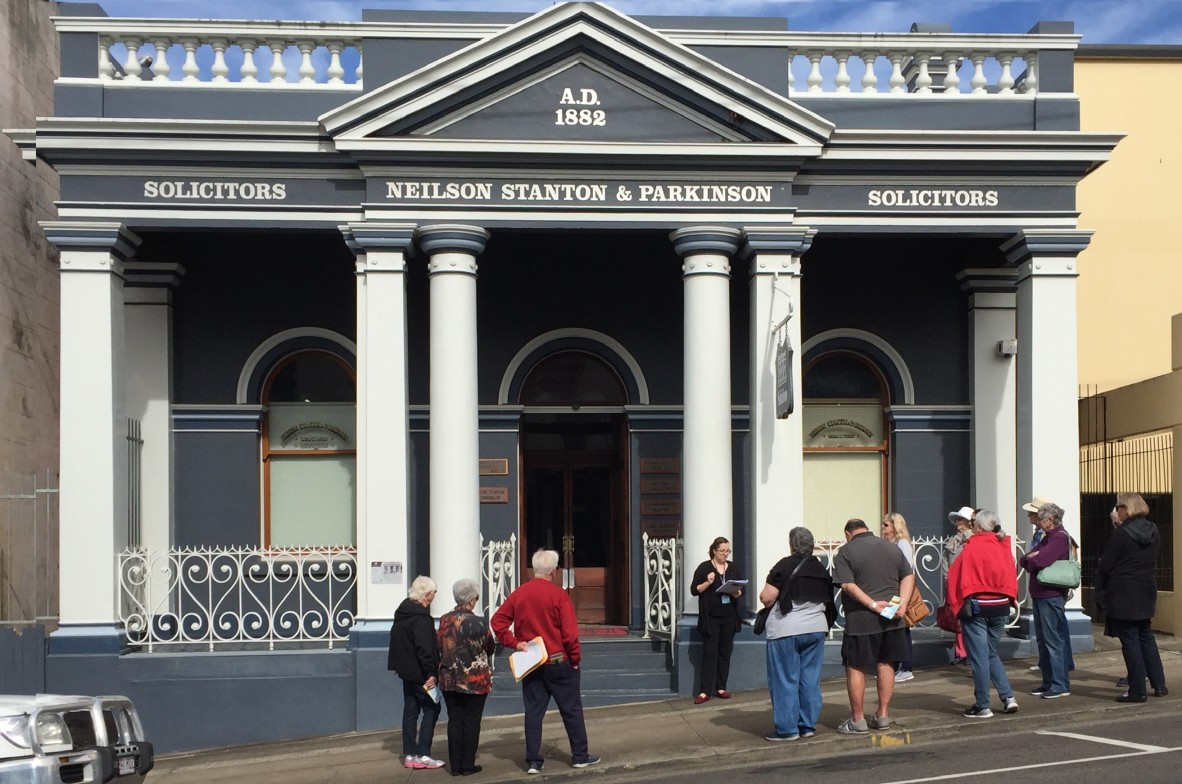
Hotels were not always owned by the licencee however the licencees had to apply every year and abide by the regulations according to the Licensing Branch. There is a very busy history of hotels in Gympie’s early days – of licences applied for, granted or not granted. Hotels built, sold, licences transferred many times. Hotels commencing and closing within months.
The many hotels gave the thousands of gold miners a place to socialise, get a drink and a meal. Gold prospector James Nash, acknowledged as the first person to find gold in Gympie, met his wife Katherine Murphy at her family's hotel called the Traveller's Rest in central Mary Street (Maryborough Chronicle, Wide Bay and Burnett Advertiser, 4 April 1868, p. 4), probably because he would have gone there for a free meal and a couple of paid drinks. The way to identify a hotel in an early photograph is to look for a lamp light. Many Gympie hotels were rebuilt several times over their history due to structural works, flood damage or fire.
Tattersalls Hotel – Mary Street, Gympie
The Tattersalls Hotel was one of the first hotel businesses built in 1868, six months after the town of Gympie was settled (then known as Nashville) (The Gympie Times and Mary River Mining Gazette, 22 October 1868, p. 2). Mail coaches once stopped at the Tattersalls Hotel where miners would come to collect their mail and have a drink. James Lynch was the licensee for Tattersalls Hotel, and the Royal Mail Line of Coaches left the hotel for Maryborough at 6am daily (Sunday’s excepted) at reduced fares of 25 shillings each way (The Gympie Times and Mary River Mining Gazette, 16 March 1870, p. 2).
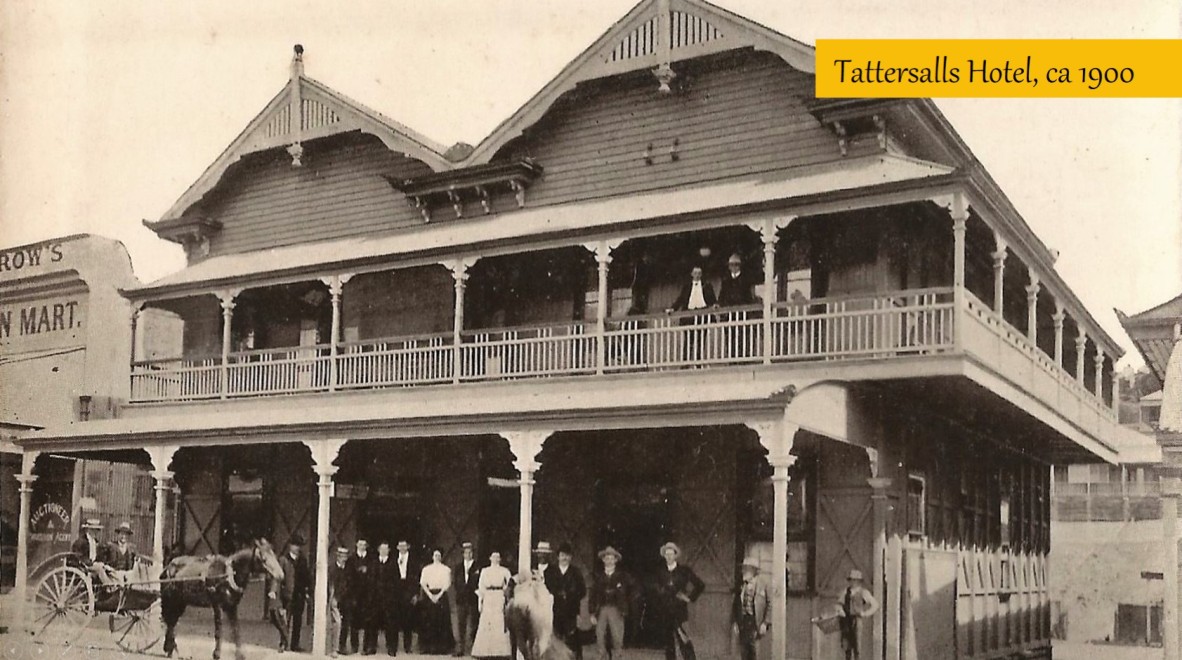
In December 1870, Lynch advertised that “meals may always be had between 6am and 10pm” and the “culinary department was under the supervision of a first-class French cook” (The Gympie Times and Mary River Mining Gazette, 10 December 1870, p. 1).
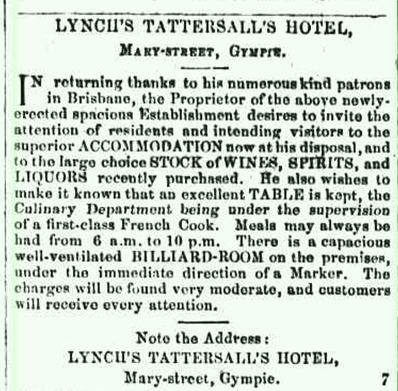
In 1887, D. O’Neill announced a drink sale with the headline “Roll up, Roll up – All drinks at the bar for 3 pence” (The Gympie Times and Mary River Mining Gazette, 19 February 1887, p. 2). In late 1898, Joe O’Neill and Mrs A. O’Neill took over the Tattersalls with the “culinary and household departments” supervised by Miss O’Neill (The Gympie Times and Mary River Mining Gazette, 15 September 1898, p. 2).
The ‘Tatts’ was the scene of a high drama in January 1899 when Mrs F J Power’s buggy threw the driver, careening out of control into one of the veranda posts. After the incident, Mrs Power fainted from shock in the hotel (The Gympie Times and Mary River Mining Gazette, 3 January, 1899, p. 3).
The Tattersalls was rebuilt and changed from its earlier foundations and then again after a fire destroyed the hotel on 26 February 1901. It was believed to have started in Bevan’s photographic studio next door and also spread to a merchant’s store and iron-monger. It was reported in The Gympie Times on 28 February 1901 (p. 3), that Mrs A. O’Neill “is probably the chief loser. Both Tattersall’s Hotel and Maynard and Pilcher’s store were owned by her, and neither were insured”. Mr J. Geary, the lessee of Tattersalls Hotel was covered for stock and furniture to the extent of 400 pounds. In July 1901, it was advertised that the Gympie Town Band would be playing selections from the balcony of the J Geary’s Tattersalls Hotel (The Gympie Times and Mary River Mining Gazette, 25 July 1901, p. 2).
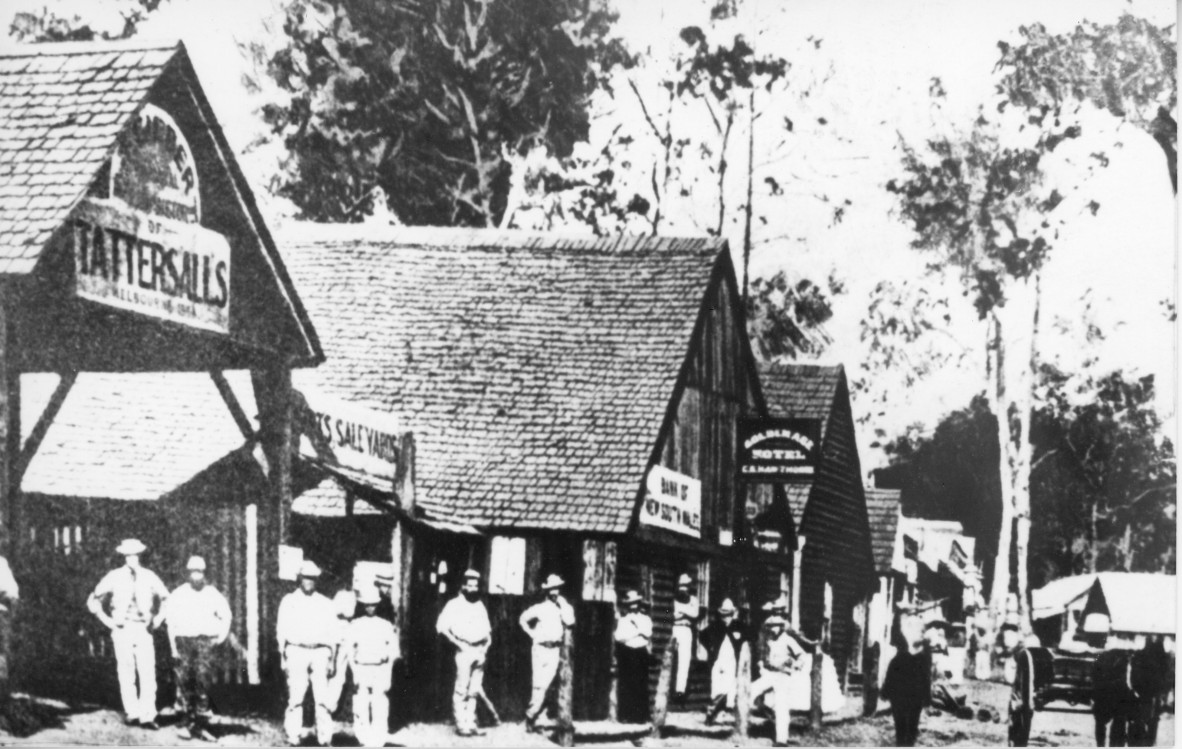
A grand two-storey hotel was built on the site and advertised in 1903. The building remained virtually unchanged, with exception of the interior renovations in 1981 and incorporated a gourmet restaurant and beer garden at the rear. Until it again burnt down on August 6, 1989 and the hotel wasn’t rebuilt. The fire and the end of the Tattersalls was lamented by pub-goers for a long time. The site is now occupied by a clothing retailer and an office equipment store.
The Royal Hotel formerly Exchange Hotel (and Varieties Theatre)– Mary Street, Gympie
At the site where the Royal Hotel still stands was originally a hotel called The Exchange Hotel with adjoining theatre at the back called The Varieties Theatre. Mr David Scowen commenced building the hotel only months after the Gold Rush, with the hotel opening around April1868 (The Nashville Times, 18 April 1868, p. 2) whilst the Varieties Theatre officially opened on the 14 August 1868 (The Nashville Times, 18 April 1868, p. 2).
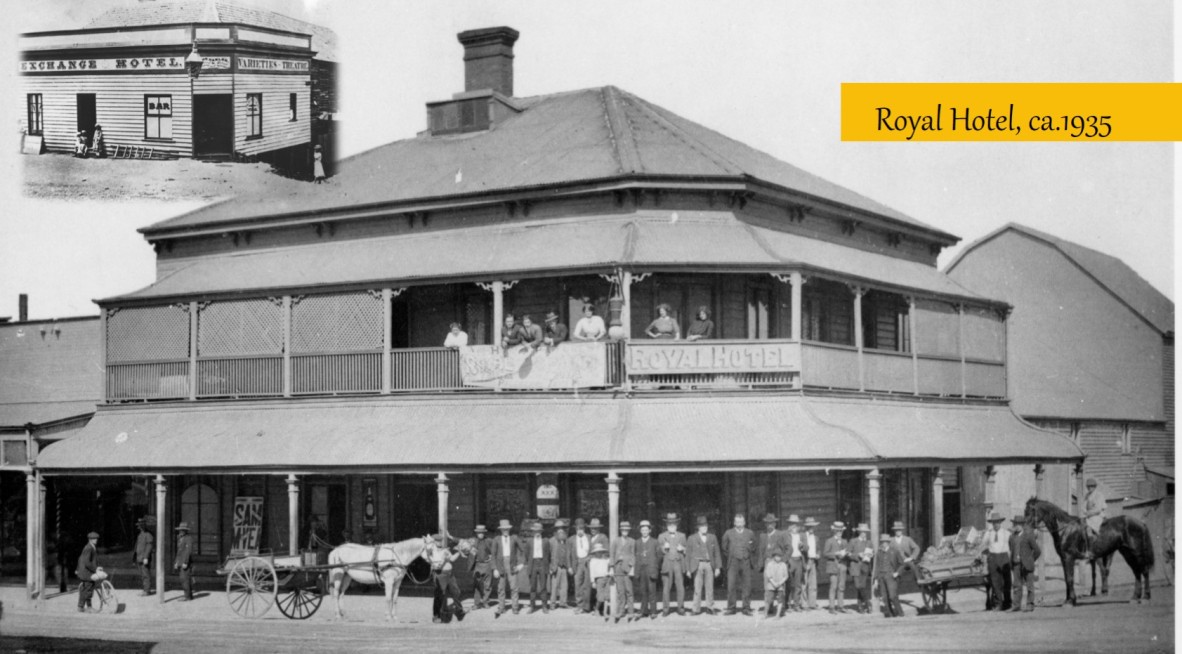
In 1875, a cyclone destroyed part of the theatre and floods submerged most of the town. The licence of the hotel was cancelled but was rebuilt into a two-storey timber structure designed by architect Hugo Du Rietz. It was officially reopened as the Varieties Hotel and Theatre (The Gympie Times and Mary River Mining Gazette, 5 August 1868, p. 2).
“The stage will be fitted with new Scenery, Decorations, etc, as soon as practicable. The body of the Hall will be much more comfortable than hitherto, and there will be good ventilation and a good Piano will always be in readiness. The Doors are spacious, and all open outwards. The Lighting will also be improved, and the Gallery and Second Seats will be more comfortable than before” (The Gympie Times and Mary River Mining Gazette, 15 January 1868, p. 2).
In 1885, the publican’s licence was granted to James Chapple who was also given permission to change the name of the Varieties Hotel and Theatre to the “Royal Hotel”, known as Chapple’s Royal Hotel and the Theatre Royal (The Gympie Times and Mary River Mining Gazette, 1 March 1876, p. 3).
In the Gympie Mining Handbook, published in 1887, it was written that the Royal's theatre and dancing room, built behind the hotel, "was crowded with audience pretty well every evening. There was a fiddle and piano for band, and there was a bar also, which almost goes without saying” (Ivimey, 1887). Locals were treated to their first movie at the Theatre Royal which was a picture of British warships passing through Suez Canal. The movie was made realistic by men behind the screen making sounds such as waves lapping and sirens blowing!
In December 1926 (The Week, 31 December 926, p. 10) and peculiarly, again in June 1929 (The Truth, 30 June 1929, p. 17), there were two arson attempts each, to burn the Royal Hotel. Both fires were quickly noticed and extinguished with no damage to the buildings. But sadly, tragedy struck in 1935 when a fire razed the building to the ground (The Courier Mail, 22 January 1935, p. 15). In 1938, Bulimba Brewery purchased the site (The Courier Mail, 20 October 1938, p. 9) and rebuilt the Royal Hotel, reopening in 1939, sans the theatre, with an elegant art deco façade that it is now visibly known. The Royal Hotel closed for two years then reopened in 2007, having undergone a million-dollar facelift which restored the hotel to its former glory. The Royal Hotel continues to trade in its original position today.
Further Reading:
Hotel History of Gympie: part two
Contact Rochelle: rochelle.bull@gympie.qld.gov.au
Comments
Your email address will not be published.
We welcome relevant, respectful comments.